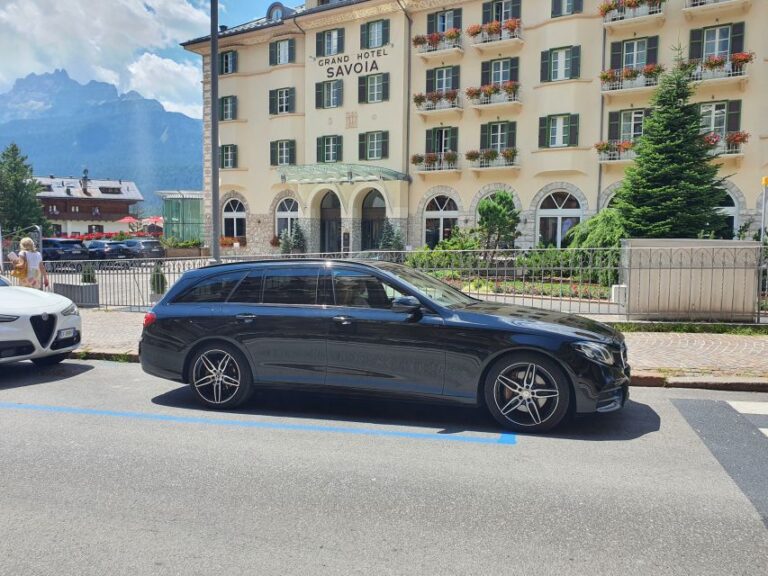When you’re in Venice, make sure to swing by Piazza San Marco, or St. Mark’s Square. It’s the city’s main square and home to some of its most famous sights. One of these is the Palazzo Ducale, or Doge’s Palace.
You can’t miss it – the palace takes up a whole side of the square. Its white façade is intricate and lacy-looking, and it faces the Canal of San Marco. Even if there’s a line of travelers waiting to get in (and there probably will be), we think it’s worth the wait and the admission fee. Trust us, you won’t regret it.
A Palace with a Long History
The Doge’s Palace has been around since the 12th century. Before that, there was a walled castle on the same spot dating back to the 10th century. And even before that, there was an earlier Doge’s castle nearby in the Rialto neighborhood.
So what exactly is a Doge? The Doges were the rulers of the Republic of Venice. They were mostly noblemen and they held a lot of power – until Napoleon showed up in the 18th century, that is. A tour of the palace lets you see where the Doges lived and worked. You’ll get a sense of just how wealthy they were from all the fancy rooms and decorations.
Starting Your Tour
To start your visit, head to the Porta del Frumento (Corn Gate) to enter the courtyard. Here, you’ll see some cool architectural features like:
- The Foscari Arch, named after Doge Francesco Foscari
- The Giants’ Staircase, with statues of Neptune and Mars at the top
- Two 16th-century water wells in the center of the courtyard
On the right side of the courtyard is the Renaissance wing, and on the left is the Piazzetta. Straight ahead, you’ll catch a glimpse of the domes of Saint Mark’s Basilica.
Climbing the Golden Staircase
From the courtyard, make your way into the Renaissance wing. You’ll come to the Scala d’Oro, or Golden Staircase. It’s super ornate – you’ll see why they call it “golden.” Climb the stairs to reach the upper levels of the palace.
Exploring the Doge’s Apartments
One of the areas you’ll visit is the Doge’s Apartments. These rooms are from the 15th century and they’re decked out with fancy marble fireplaces and carved wooden ceilings. The apartments include:
- The Sala delle Scudo (Shield Room), which has maps on the walls and two huge globes representing the Earth and the Sky
- The Sala dei Filosofi (Hall of the Philosophers) next door
- The Sale del doge, which were the Doge’s private rooms
the Great Council Chamber
The Chamber of the Great Council is probably the biggest room in the palace – maybe even one of the biggest in Europe. This is where the Great Council (Maggior Consiglio) used to meet. Take a seat along the wall and just take in the size of the room and all the incredible art on the walls and ceiling.
One painting you can’t miss is ‘Paradiso’ by Jacopo Tintoretto. It’s said to be the longest canvas painting in the world. Below the ceiling, you’ll see portraits of 76 Doges, also painted by Tintoretto and his son. One of the portraits, of Doge Marin Faliero, is covered with a black cloth because he betrayed the Republic.
Visiting the Poll Room
The Sala della Scrutinio (Poll Room) is another impressive space. It used to be the library, but later it was used for elections, especially for choosing a new Doge. The art in this room is from the 16th and 17th centuries and shows off the Republic’s military victories. Like in the Great Council hall, there are portraits of the Doges along the ceiling.
Climbing Higher for More Stunning Rooms
Go up another flight of the Golden Staircase to see even more amazing rooms, like:
- The Sala delle Quattro Porte (Hall of the Four Doors), an antechamber leading to important meeting rooms. It gets its name from the four marble doorways. The ceiling is coffered with detailed stucco work. There are also paintings by Tintoretto and Titian.
- The Sala del Collegio, or Council Chamber, where the Full Council met. It has ceiling paintings by the Renaissance artist Veronese.
- The Senate Chambers, where the Consiglio dei Pregadi (Senate) used to meet. Like many other rooms, it has amazing art, including works by Tintoretto.
Checking Out the Armory and Prison
Your palace ticket also includes access to the Armory. Like most European castles and palaces, the Doge’s Palace has a collection of weapons from centuries of warfare. You’ll see things like armor, crossbows, guns, swords, torture devices, and even some giant ship lanterns taken from the Turks. The collection is spread out over several rooms.
The palace wasn’t just a government building and the Doge’s home – it was also where the courts were. And in the early years, the prisons were here too. There were cells in the basement called Pozzi (wells) and cells in the attic under the lead roof called Piombi.
The famous lover Casanova was once held in the Piombi cells for crimes against the church. Legend says he escaped by digging through the floor and climbing onto the roof. You can see his cell on a special “Secret Itineraries Tour.”
If you have the regular ticket, you’ll get to visit the New Prison across the canal. It’s connected to the palace by the Bridge of Sighs. From the bridge, you can see the canal below and the island of San Giorgio Maggiore in the distance. The bridge got its name because prisoners would “sigh” at this last pretty view before being locked up.
In the New Prison, you’ll see heavy wooden doors with iron bars, gloomy cells, and the prison courtyard. It’s a stark contrast to the fancy rooms of the palace.
Plan Your Visit
Getting There: The Doge’s Palace is at #1 San Marco Square, right next to Saint Mark’s Basilica.
Ticket Info:
- Adult admission is 16.00€. This also gets you into the St. Mark’s Square Museums (Museo Correr, Museo Archeologico Nazionale, and the Monumental Rooms of the Biblioteca Nazionale Marciana).
- Admission is free with the Museum Pass. The pass is valid for 6 months and gets you one entry to each of these museums: Doge’s Palace, the St. Mark’s Square Museums (listed above), Ca’ Rezzonico (Museum of 18th-Century Venice), Museum of Palazzo Mocenigo, Carlo Goldoni’s House, Ca’ Pesaro (International Gallery of Modern Art and Oriental Art Museum), Glass Museum (Murano), Lace Museum (Burano), and the Natural History Museum.
The Doge’s Palace is an incredible glimpse into Venice’s past. With its mix of Gothic and Renaissance architecture, lavish decorations, and fascinating history, it’s a must-see on any trip to Venice. Just be prepared for crowds and a lot of walking. But trust us, it’s worth it.



